Beijing: A Foreigner’s Survival Guide to Ordering and Eating Peking Duck in Beijing
19 Jun 2014Location: Beijing, China
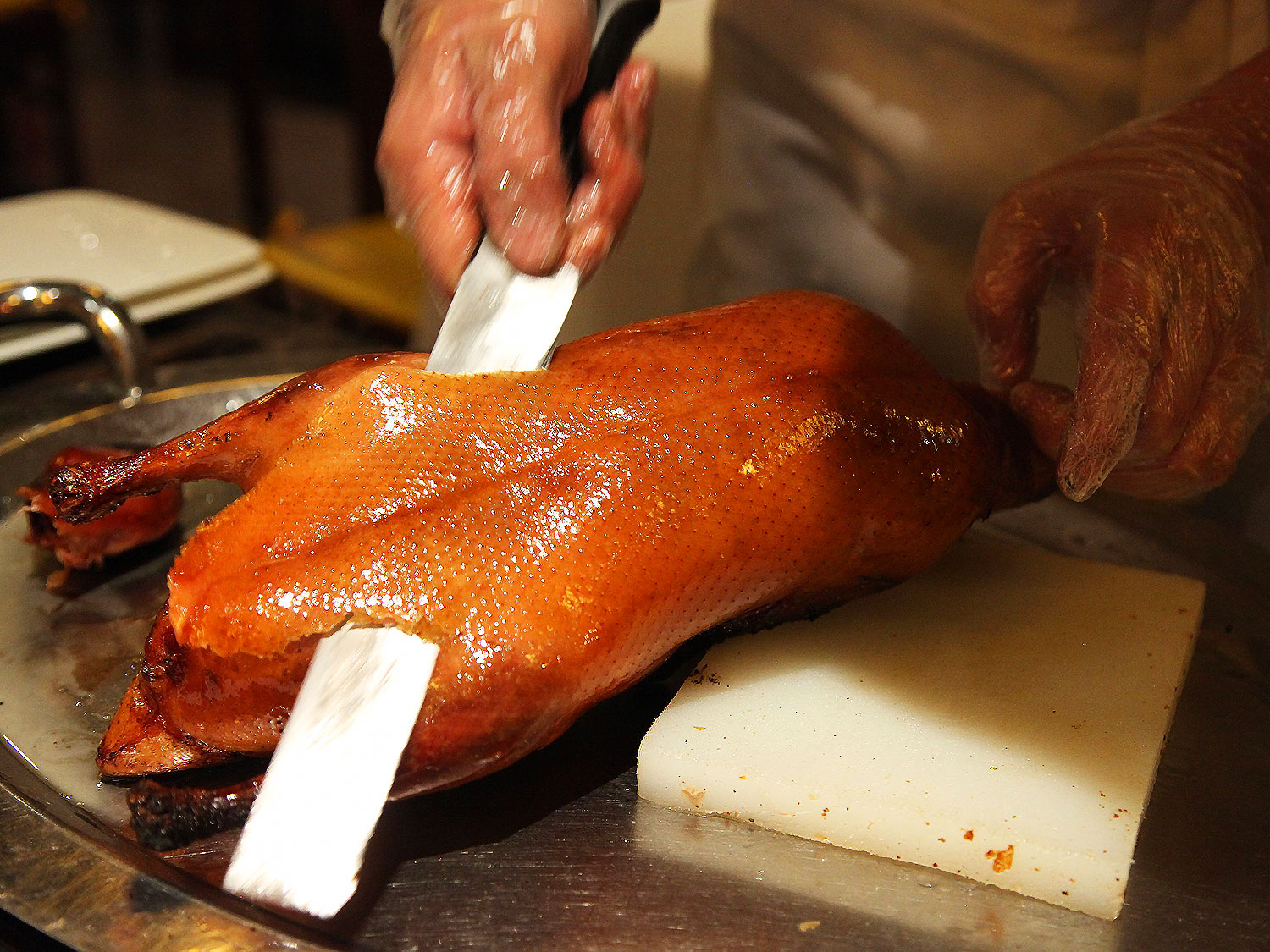
The title of this post is sort of misleading, as it's actually not that difficult to figure out how to eat Peking duck as a foreigner. The menus at the restaurants all have pictures (and barring that, you can always pantomime a duck, which serves the dual purpose of placing an order and entertaining the waitstaff), and the waitstaff will baby you through every step of the process.
The only real decisions you need to make are a) which restaurant to go to, b) what side dishes to get, c) what quality of duck you want, and d) if you'd like it with garlic or without.
How Peking Duck is Made
I did a painstaking amount of research in deciding which restaurant to go to. We only had one shot at it, and we wanted to make sure that our RMB were well spent. A peking duck meal will set you back around 200 RMB (about $32), before any additional side dishes or drinks. It's not expensive by NY or SF prices, but it's on the higher end of the spectrum in a city like Beijing, where a cheap meal will cost you under a buck and you'd be hard pressed to spend more than ten or so.
Based on a couple of Chowhound threads, some tips from readers, and an article by Fuchsia Dunlop in the Financial Times, we were torn between the ultra-modern Da Dong, recommended by Fuchsia, and the more classic Siji Minfu, recommended by Reuters' Beijing correspondent Megha Rajagopalan.
Peking Duck has a rich history in palace cuisine, but it wasn't introduced to the public until Yang Quanren opened Quanjude restaurant in 1864 where, according to Dunlop, the technique of hanging the ducks upright in an oven heated with fruitwood fires was introduced. Prior to that, ducks had been roasted laying down in a closed oven. The hanging technique leaves more space for rendering fat to drain, resulting in crisper, dryer skin.
That oven is not the only elaborate part of the process, which starts with a 100-day old Pekinese duck that has been force-fed for the last several days of its life to plumpen up—at least, that's how the most highly regarded do it. Air is then forced into the neck cavity of the slaughtered, plucked duck, inflating its skin sort of like those lizard balloons the the first Shrek movie. The idea is to completely separate the skin from the meat underneath, which allows for the skin to render out fat from both sides, basting the meat as it cooks.
But we're not anywhere near cooking phase yet. Next, the guts of the duck are removed. With American butchery practices, the guts are removed through the business-end of the digestive system. Ever notice how your chicken or duck has a huge cavity cut out at the bottom between the legs? With a Peking duck, presentation is of paramount importance, so the guts are instead removed, surgeon-like, through a tiny incision under one of the wings.
Next up, a couple branches of wheat or sorghum are inserted into the chest cavity to keep the skin stretched taught and away from the meat as it roasts. The prepared duck is then doused with boiling water (this helps tighten the skin up, as well as causing it to paradoxically dry faster), given a coating of maltose syrup—this is what gives it its rich, lacquered color—and left to hang and dry for at least 24 hours.
Finally, the duck is hung with its neck wrapped around a metal hook, boiling water is poured into its cavity, and it's and placed inside a tall oven heated by fruitwoods (Dunlop says that Da Dong uses a combination of apple, pear, and jujube wood). The water inside slowly boils away, steaming the meat, while the smoky fire renders the skin.
What emerges from the oven is one of the pinnacles of culinary greatness. I haven't gotten around to naming the Seven Culinary Wonders of the World, but Peking duck would be high in the running for one of those coveted slots.
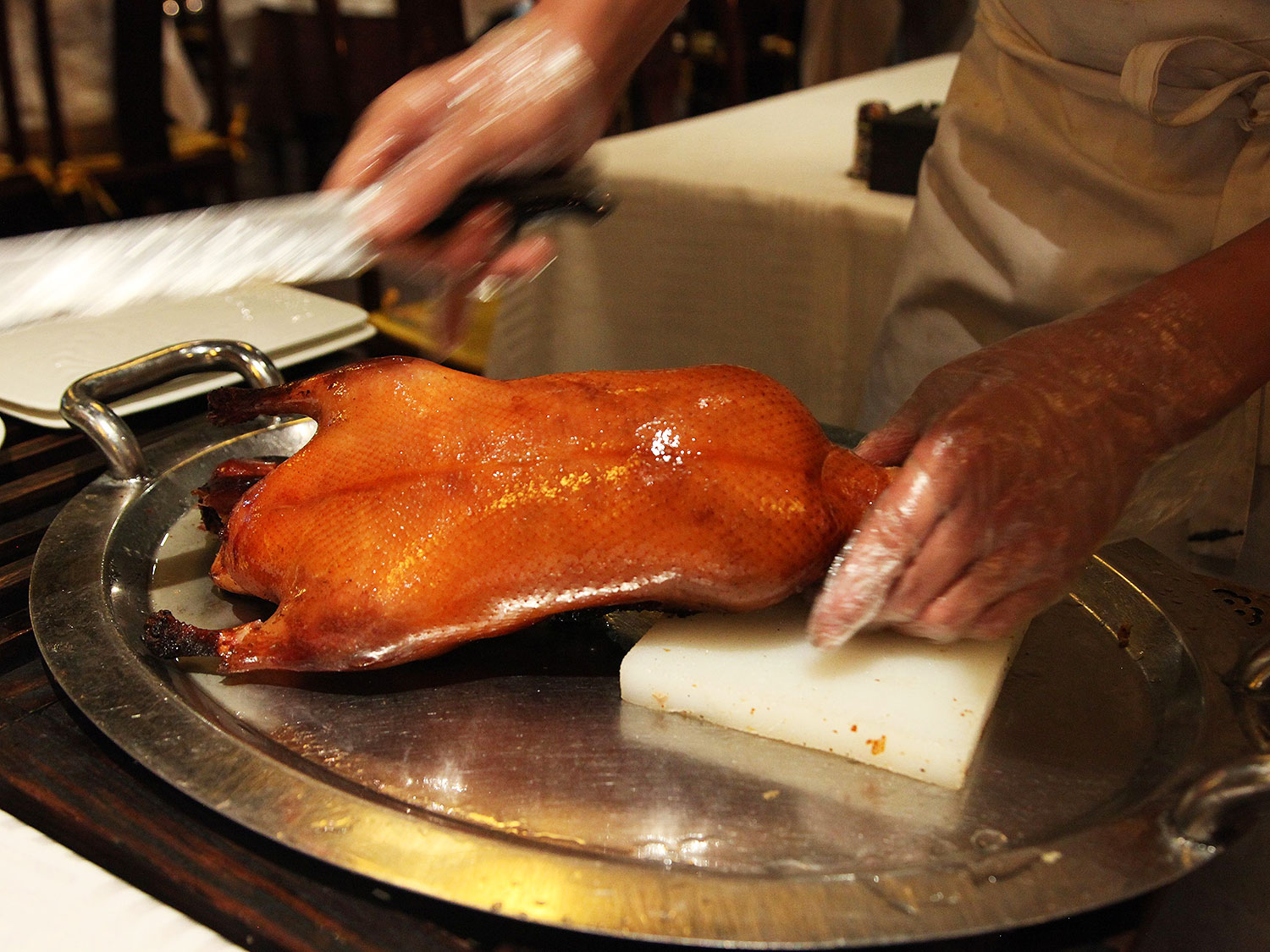
Point is, it's a pain-in-the-butt process, and while you can follow my home-version and get yourself decent results, a pilgrimage to one of Beijing's top Peking duck restaurants is something that should be on the lifetime checklist of all worshippers at the Church of Serious Eating.
In the end, we opted for Siji Minfu, in part because of it's slightly better price point and more classic atmosphere, and more importantly because I'll almost always take the locals' advice when it comes to dining out.
We were not disappointed.
How to Order
Your main options on the menu are the side dishes, and most restaurants offer a pretty vast array. If you want to go all duck, order some heart, liver, or tongue—all delicacies that you won't get to taste with the standard whole Peking duck.
Or, if you'd like to taste another of Beijing's typical dishes, get a plate of zha jiang mian, hand-pulled noodles served with a bowl of oily fermented soybean paste, along with an array of toppings—usually slivered cucumber and watermelon radish, along with bean sprouts and fresh soy beans. My mom used to serve us a dish she called "Peking noodles," which always tasted like vaguely Chinese spaghetti Bolognese. The real stuff is much funkier, colder, fresher, and at least in Beijing, less meaty as well. The version at Sijin Minfu had little chunks of crisp pork belly mixed into the sauce. Other versions I had around town had a bit of ground pork, or no meat at all.
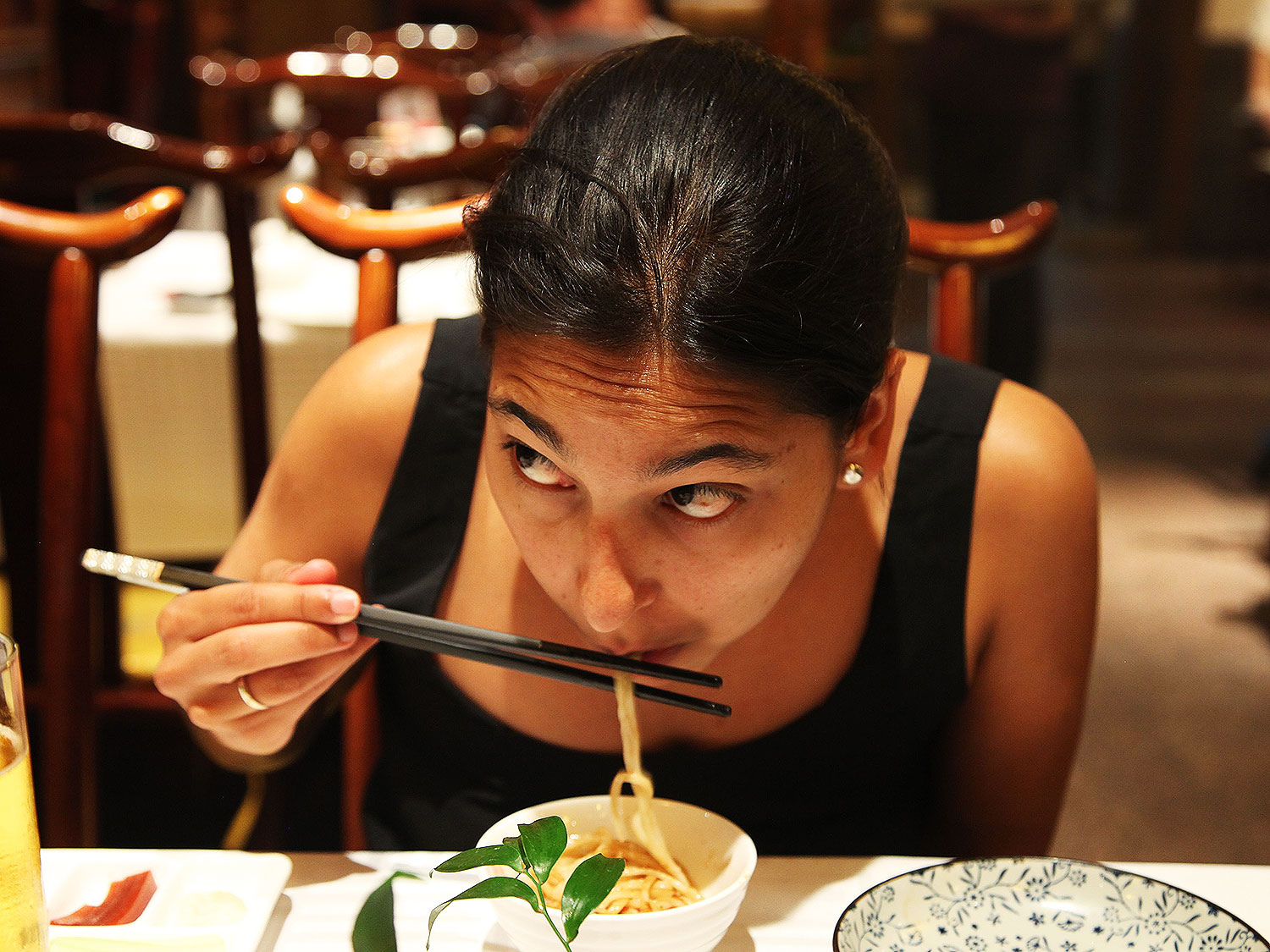
One thing you'll quickly learn (or in our case, after five or six screw-ups): Those little bowls they helpfully hand to you at the beginning of the meal? They are not share plates. They're for filling up on the thick, bland broth that that have floating around the restaurants in tea kettles (I have no idea what it is, but it tastes sort of like mildly thickened, unseasoned cabbage water).
When ordering the duck itself, you'll have the option to order a whole duck or a half duck, with the whole duck coming in two different levels of quality, which relates to the duck's feeding—the pricier duck will have been raised and force-fed a bit longer, rendering it more succulent and fatty. You should pay the slightly higher cost (around 20 RMB) for the better duck, and definitely order a whole duck, which will guarantee that it's being pulled fresh and hot out of the oven for you.
How to Eat
After that, just sit back and let the waitstaff carry you through your meal. Here's how it'll go.
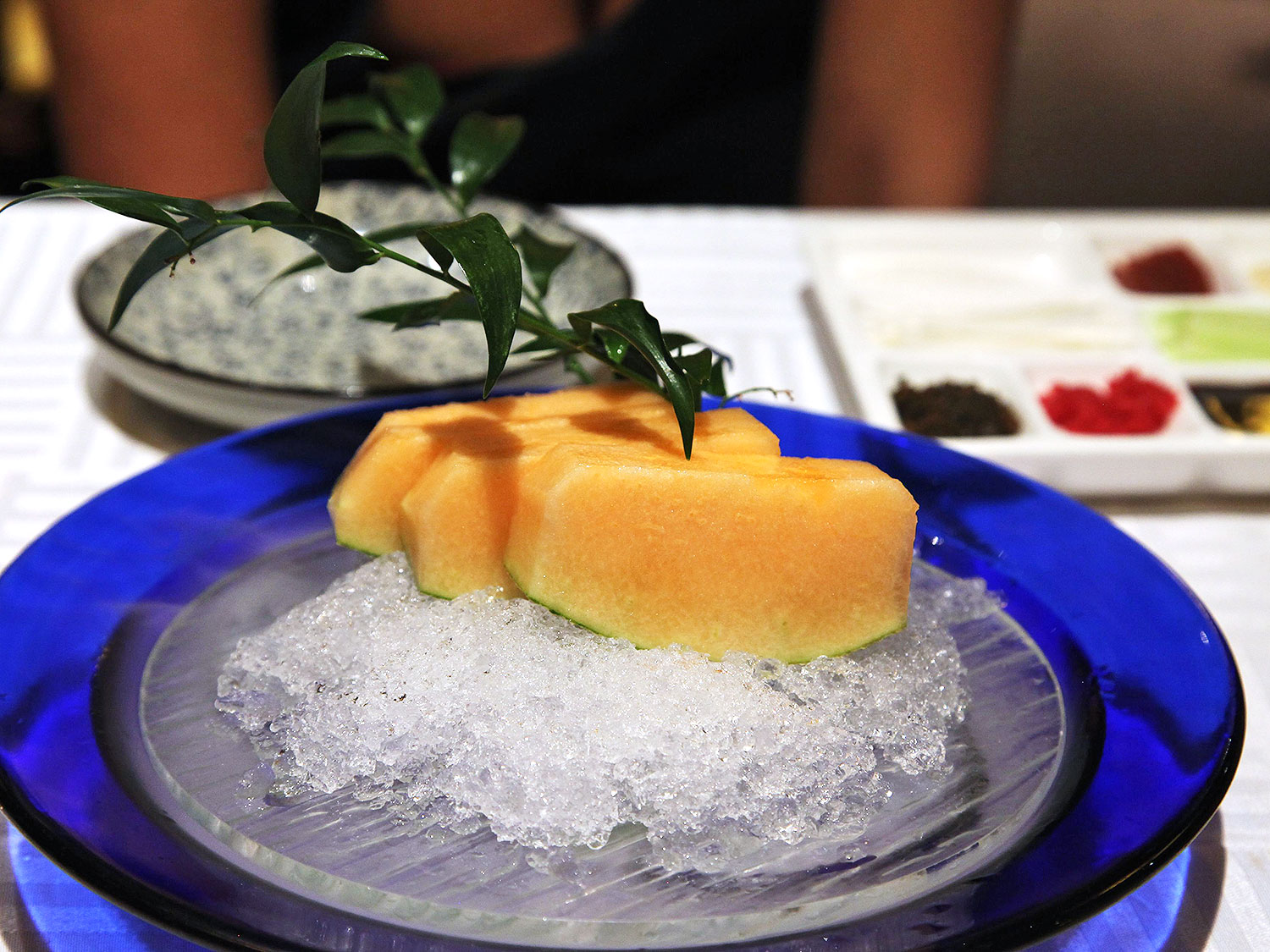
Meals start with fresh seasonal fruit. In our case, cantaloupe, followed by your chosen starters and side dishes. When your duck is ready for you (and not the other way around), it'll be carted out into the dining room on a large platter by a knife-wielding chef.
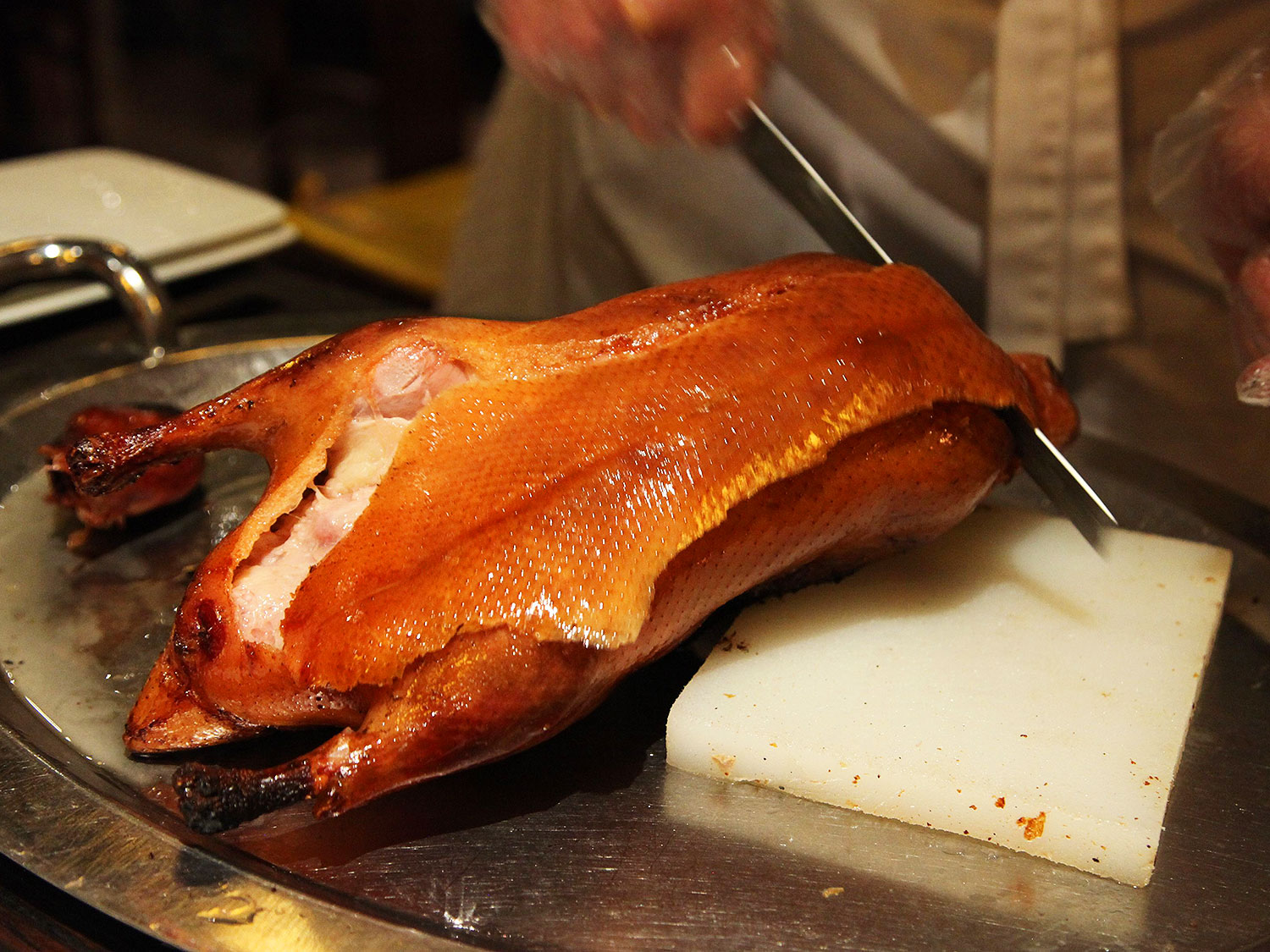
The chef starts by cutting off the heat and carefully splitting it in half, revealing the ducks brain—intended to be eaten at the end of the meal. He goes on, removing the skin from the breast of the duck in three wide strips. Watch carefully, because it takes literally seconds from start to finish.
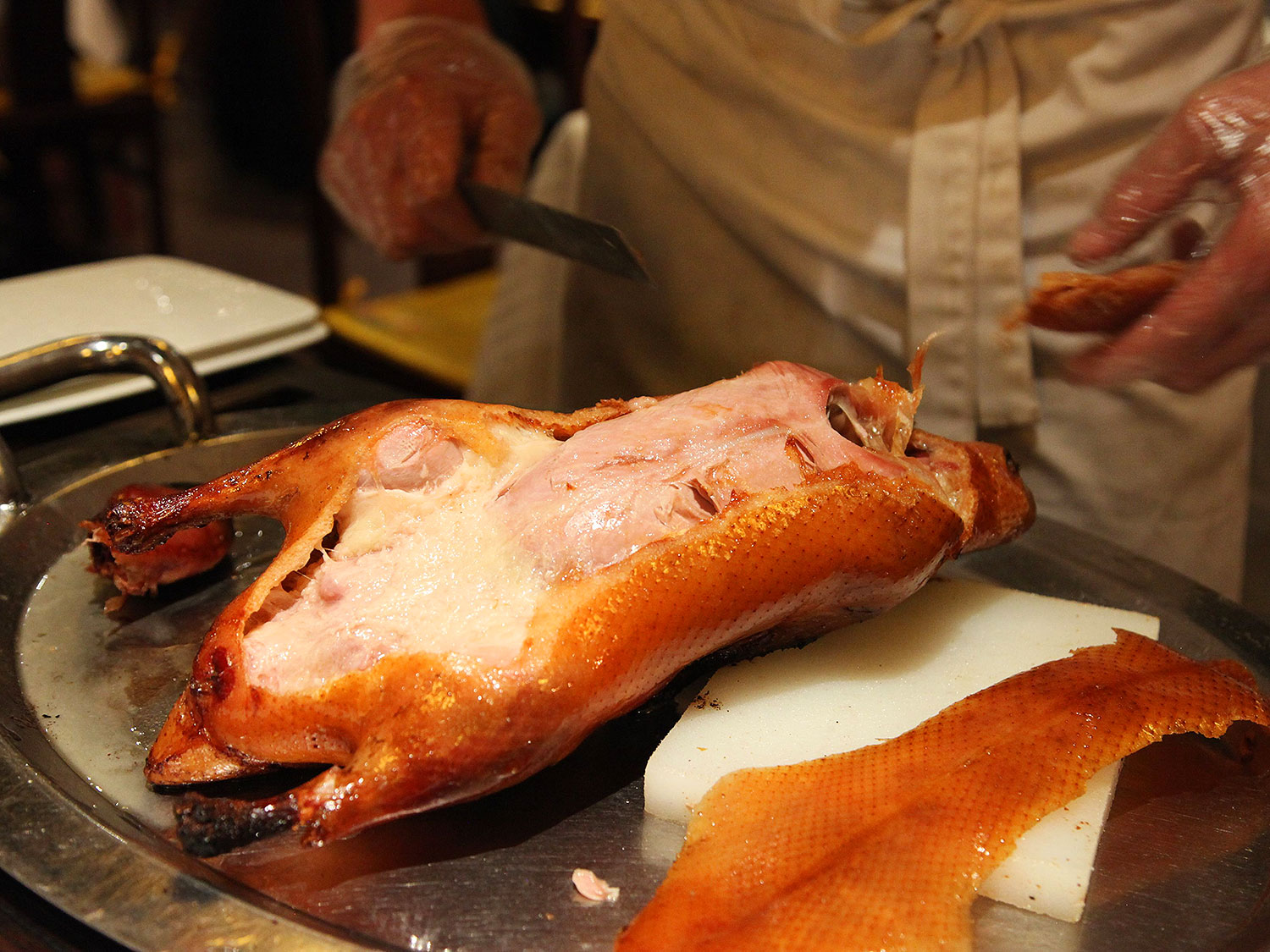
The most incredible part is that the flesh underneath is completely undisturbed—you can clearly see the space where the inflated skin has pulled away from the meat.

Next he uses the tip of the knife to slice out the breasts of the duck.
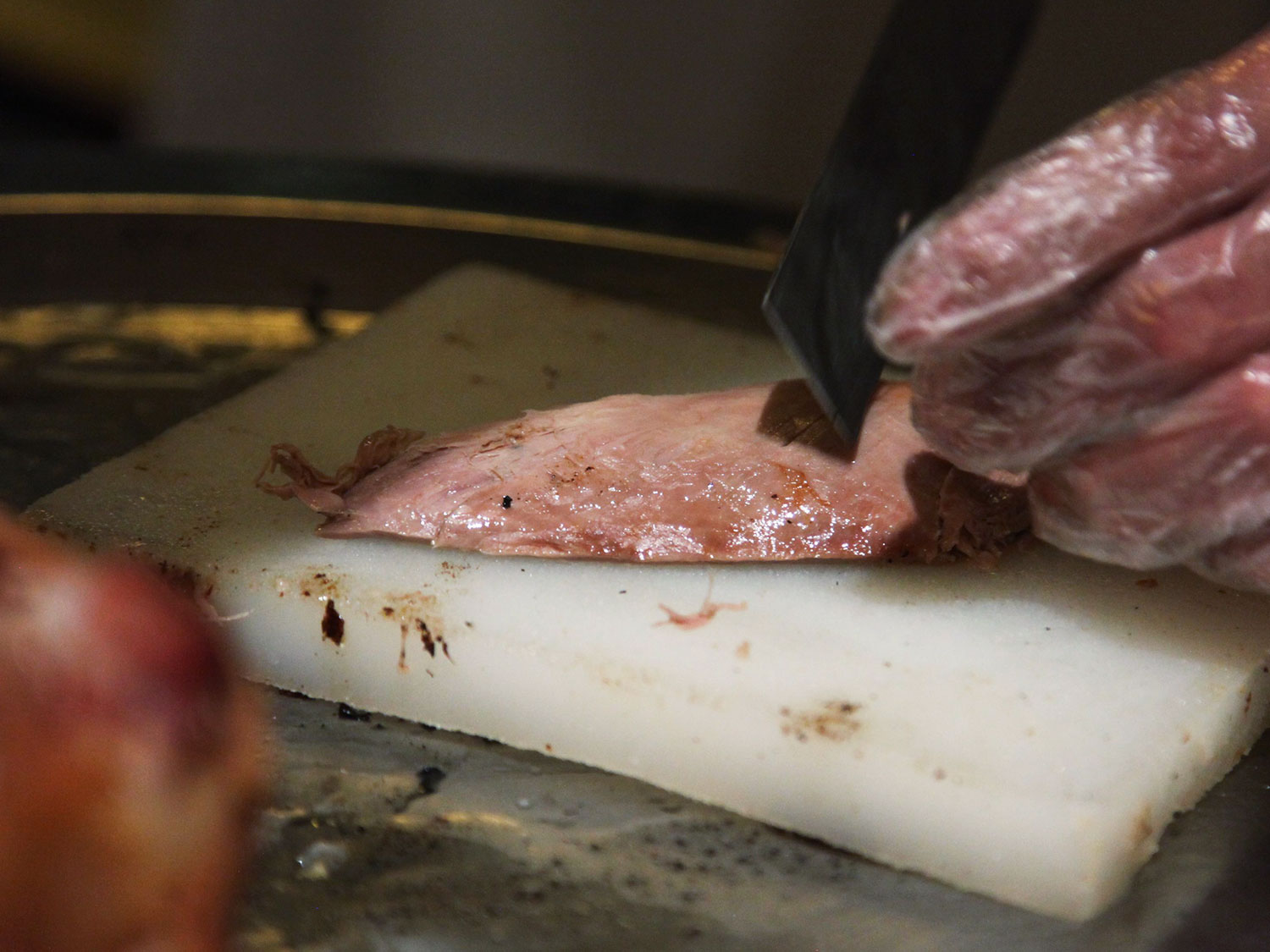
The breasts are then sliced on a bias into thin slivers. I can tell you from years of experience that slicing hot, fall-apart tender meat like that requires an insanely sharp knife.
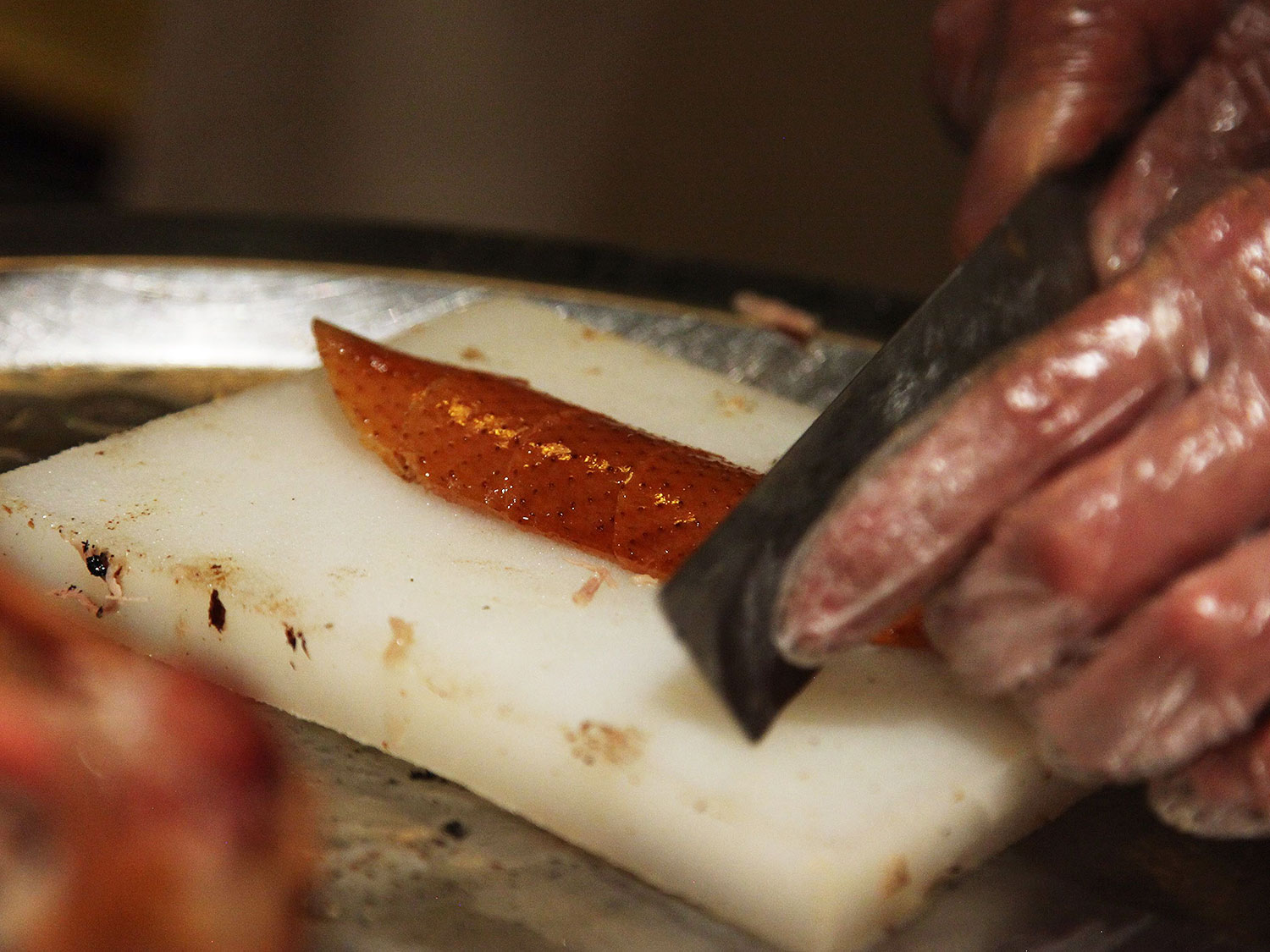
The skin from the breast is sliced similarly, at an even sharper bias.
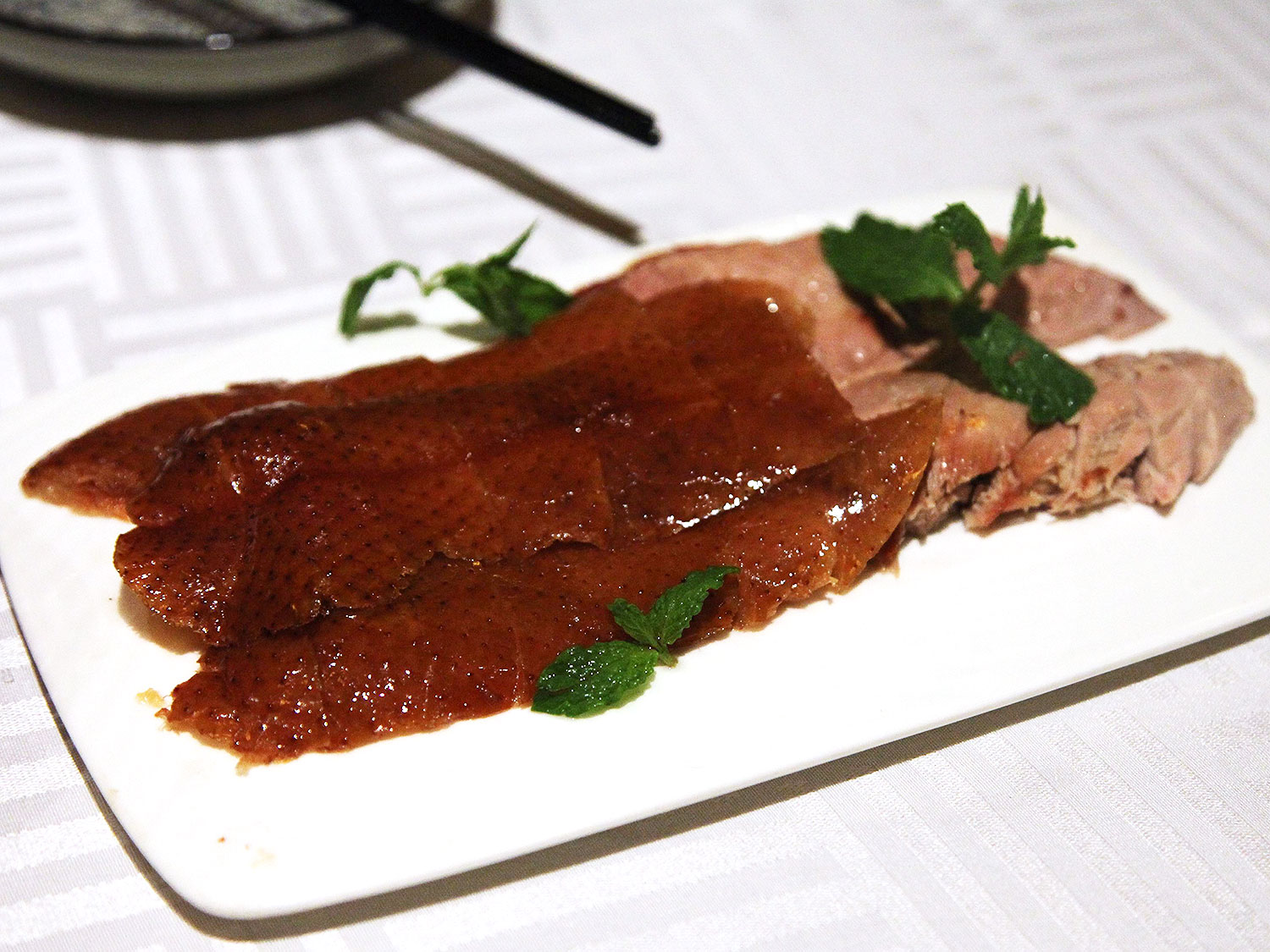
The chef lays the slivers of breast meat and skin onto a clean platter and places it on the table, urging you to dip the slivers of skin into a small dish of sugar placed in front of you. That fist bite of hot skin goes into your mouth shatteringly crisp, but almost instantly melts over your tongue in a wash of sweet, savory, smoky duck fat.
It's glorious, and it's at this point that you'll be torn: do I keep eating this mind-bogglingly crisp skin or do I keep watching the mind-bogglingly skilled carving that's going on next to my table?
I opted to watch, turning away every few seconds to nab a quick bite, hoping that I didn't miss any of the action.
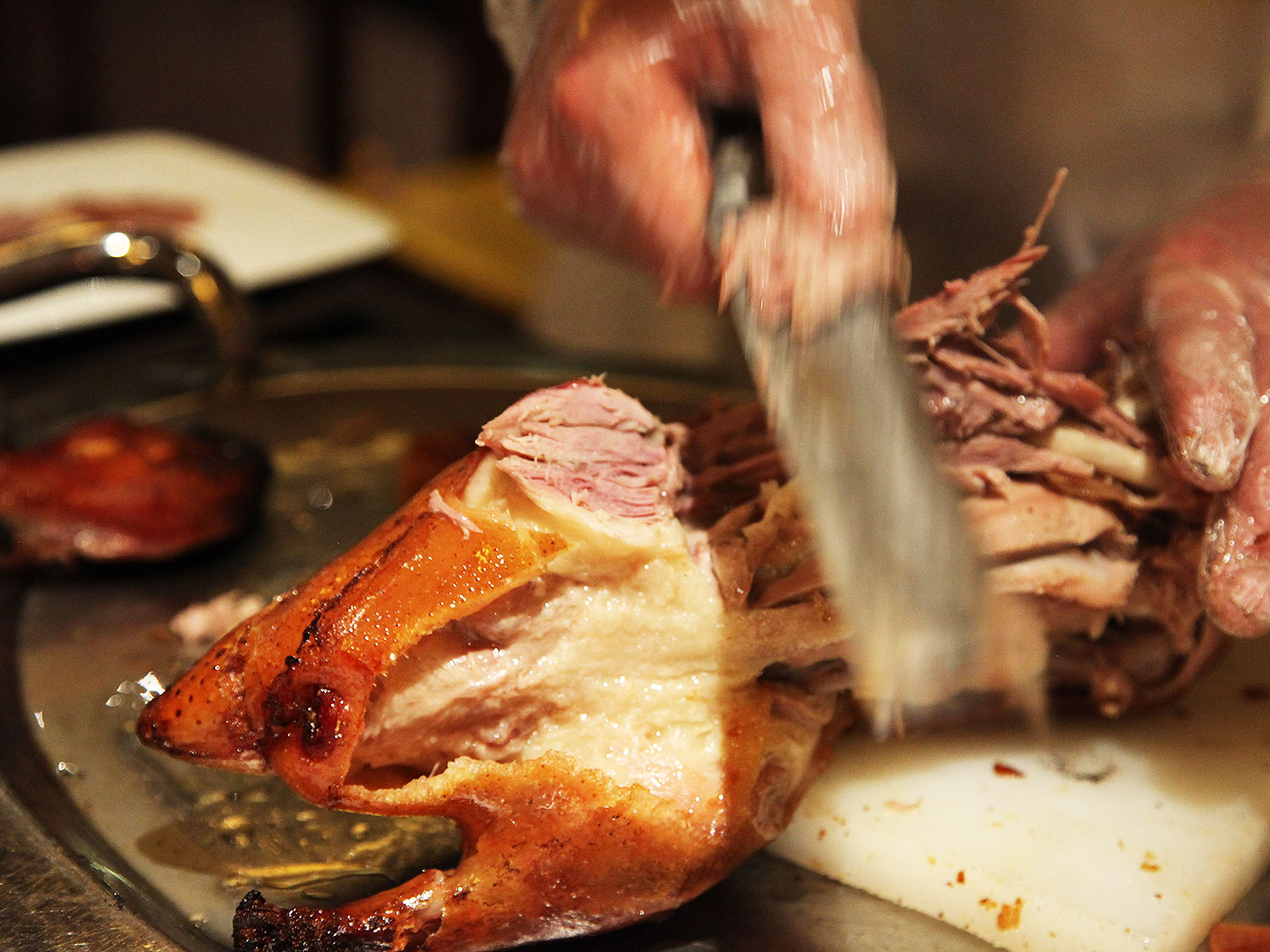
The next phase is even more insanely skilled. After removing the fat off the back of the duck, he splits off the wings, cleaning out some of the extra meat form around the sides of the carcass and placing it on a platter. The drumsticks are then bent downwards, exposing the big meaty sections of thigh, from which the chef carefully slices off half moon-shaped slivers of skin-lined flesh and starts shingling them on a platter in overlapping layers.
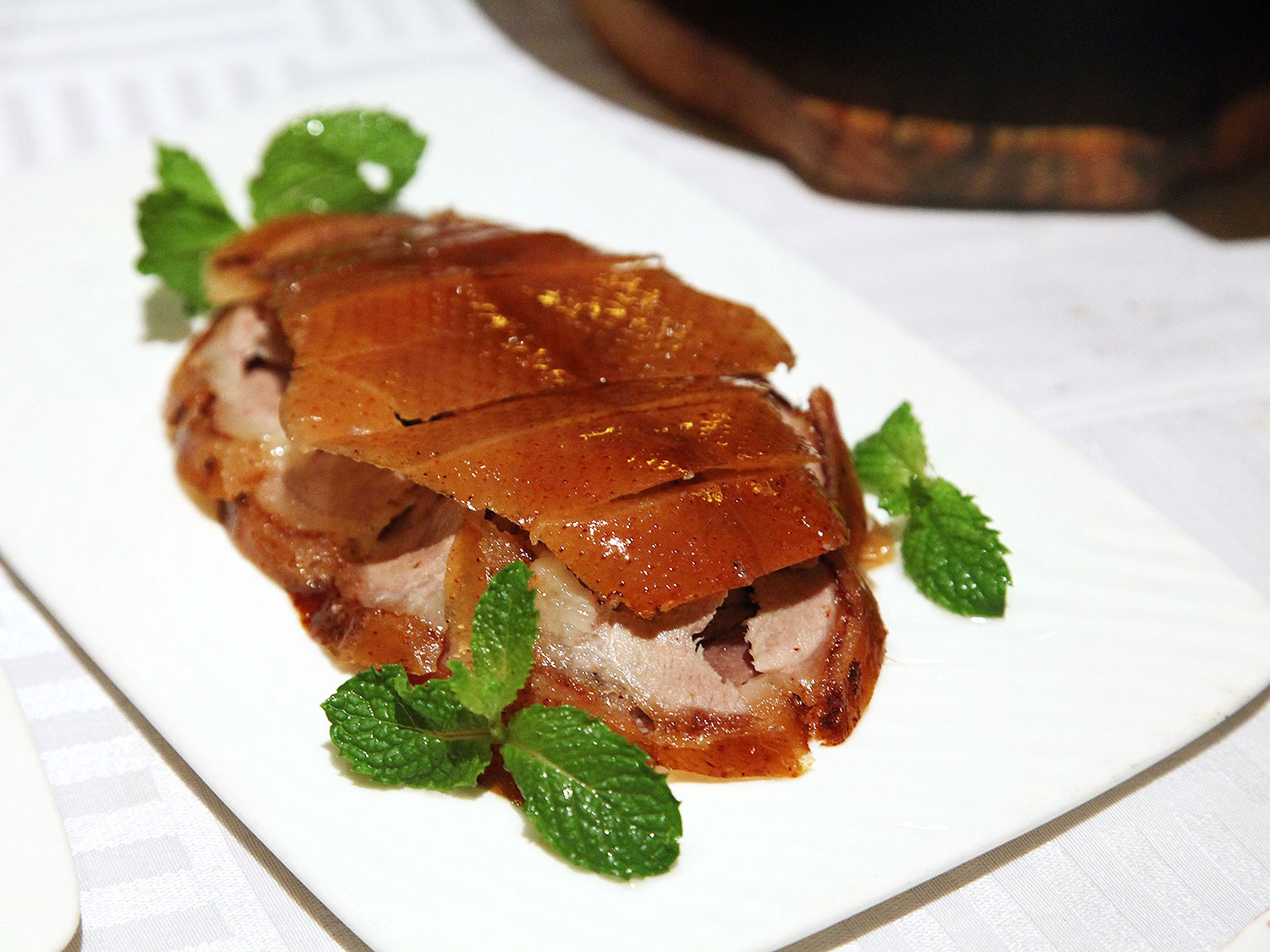
The whole thing is topped off with the sliced skin from the back and placed on the table*. Finally, the chef places the plate of collected scraps—bit of meat, the wings and drumsticks, the split head, neck, and the coveted "pope's nose"—on your table and a waitress comes over with a basket full of paper-thin bo bing—wheat-based pancakes.
*Looking at this gorgeous platter in front of me—actually, just looking at a picture of that gorgeous platter—and comparing it to what passes for Peking duck at New York's Peking Duck House, with its thick, clumsy slices, squishy, fat-saturated skin, and pancakes thick-as-tortillas makes me want to tenderly pat all of its patrons on the back of the hand with a gentle "there, there."
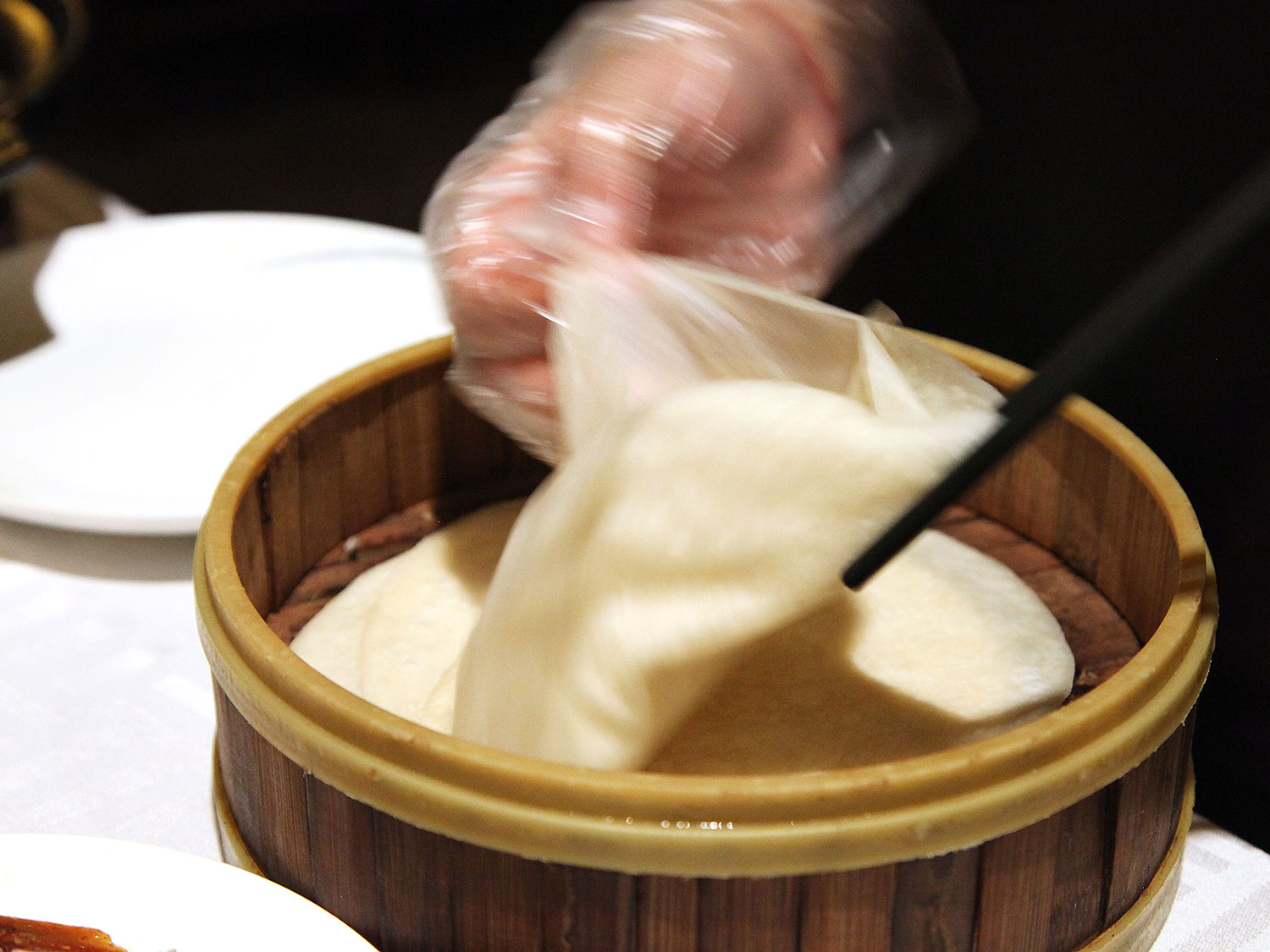
Next up in your in-flight entertainment: your waitress will demonstrate how to wrap your duck. She starts by peeling apart a single pancake. They're cooked by rolling two balls of dough together and heating them on a griddle. That way, after separating, each one ends up half as thick as you could get it on its own.
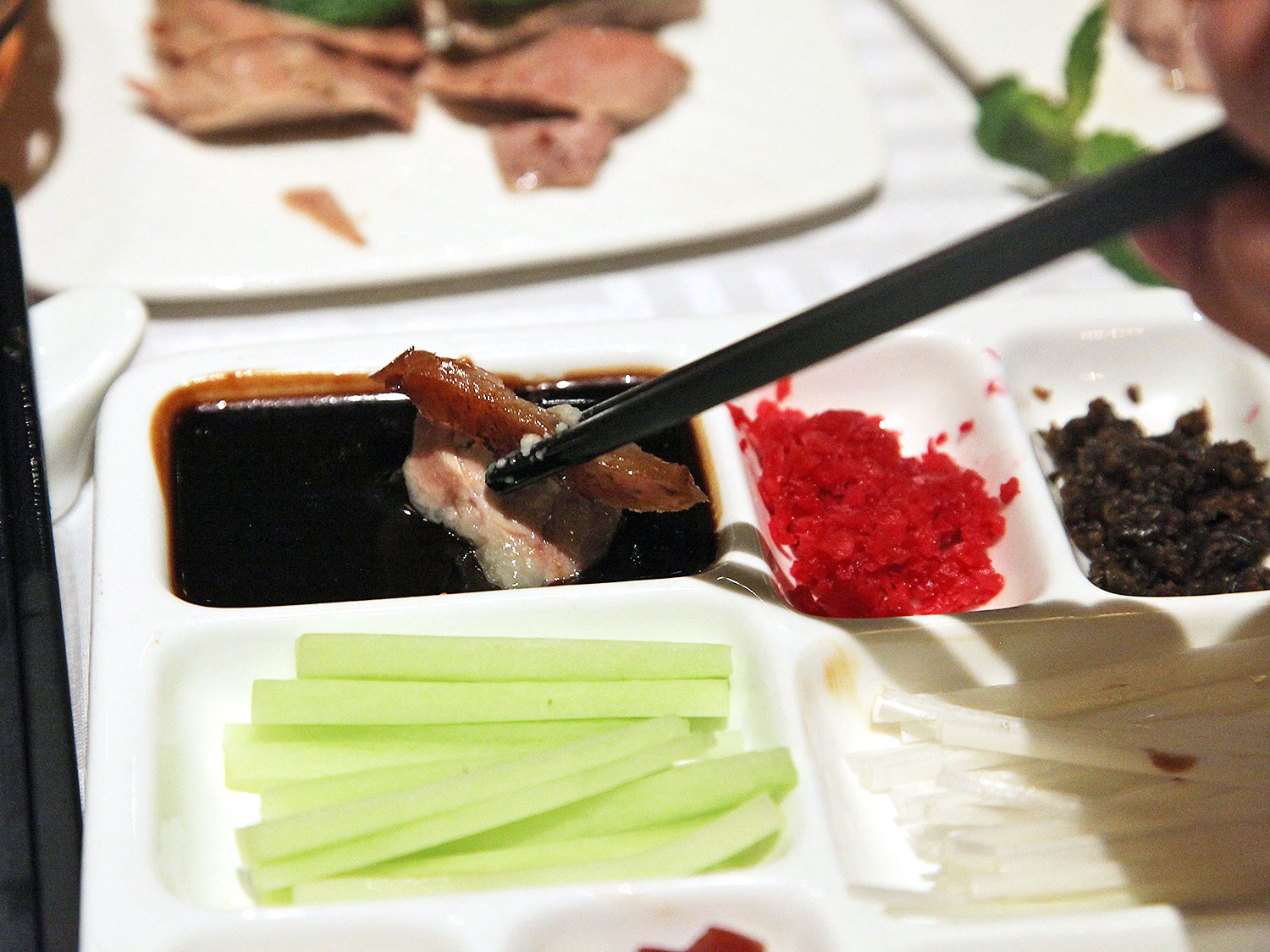
Next, she takes a bit of duck and dips it into fermented bean sauce—far saltier and more savory than the hoisin sauce you get in New York. Incidentally, after years of being annoyed at how difficult it is to spread a thin, even layer of sauce onto my pancake using chopsticks, I had a face-palm "duh" moment when she did this. It just makes so much more sense to dip the duck rather than spread the sauce.
She places two to three small slices of duck along one edge of the pancake.
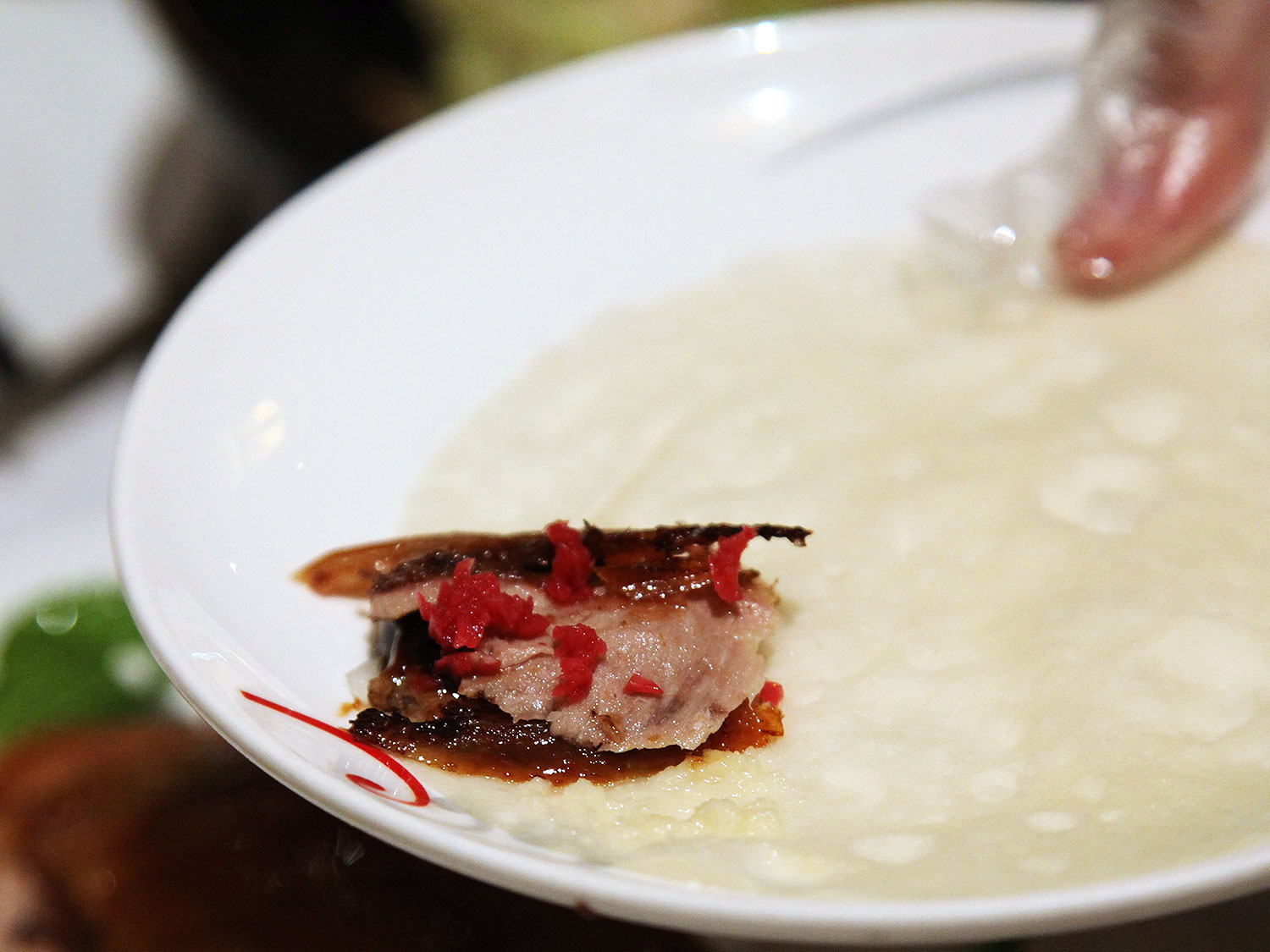
Next up: pickles. Your condiment tray will probably have at least one, perhaps two different types of chopped, very mild pickles.
If you're a man, your waitress may also ask you at this point whether you want to add some of the pungent pureed garlic from your tray. Apparently it's not a very womanly thing to partake in. Beware. That garlic is strong.
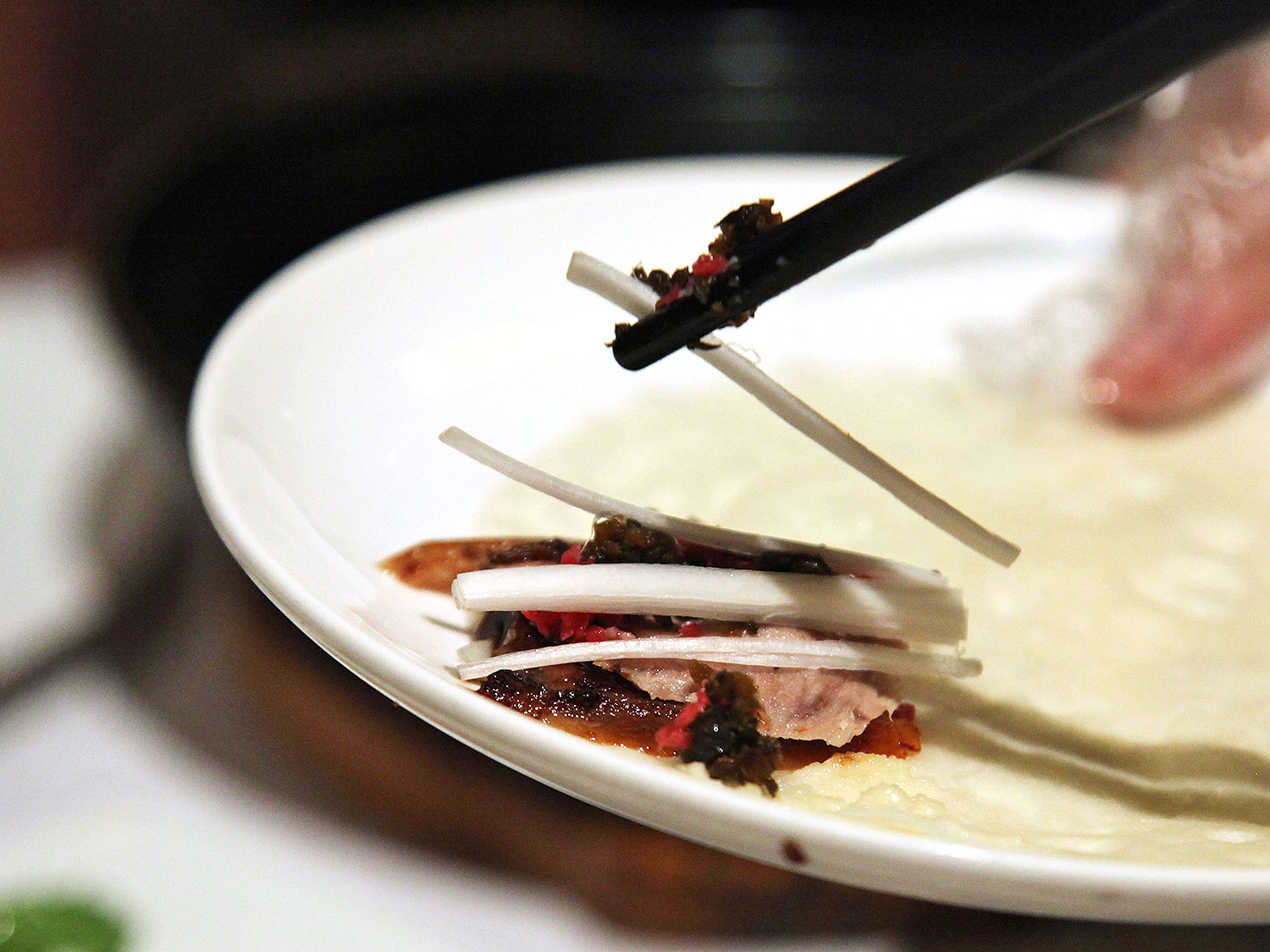
Thinly sliced scallion whites go on next...
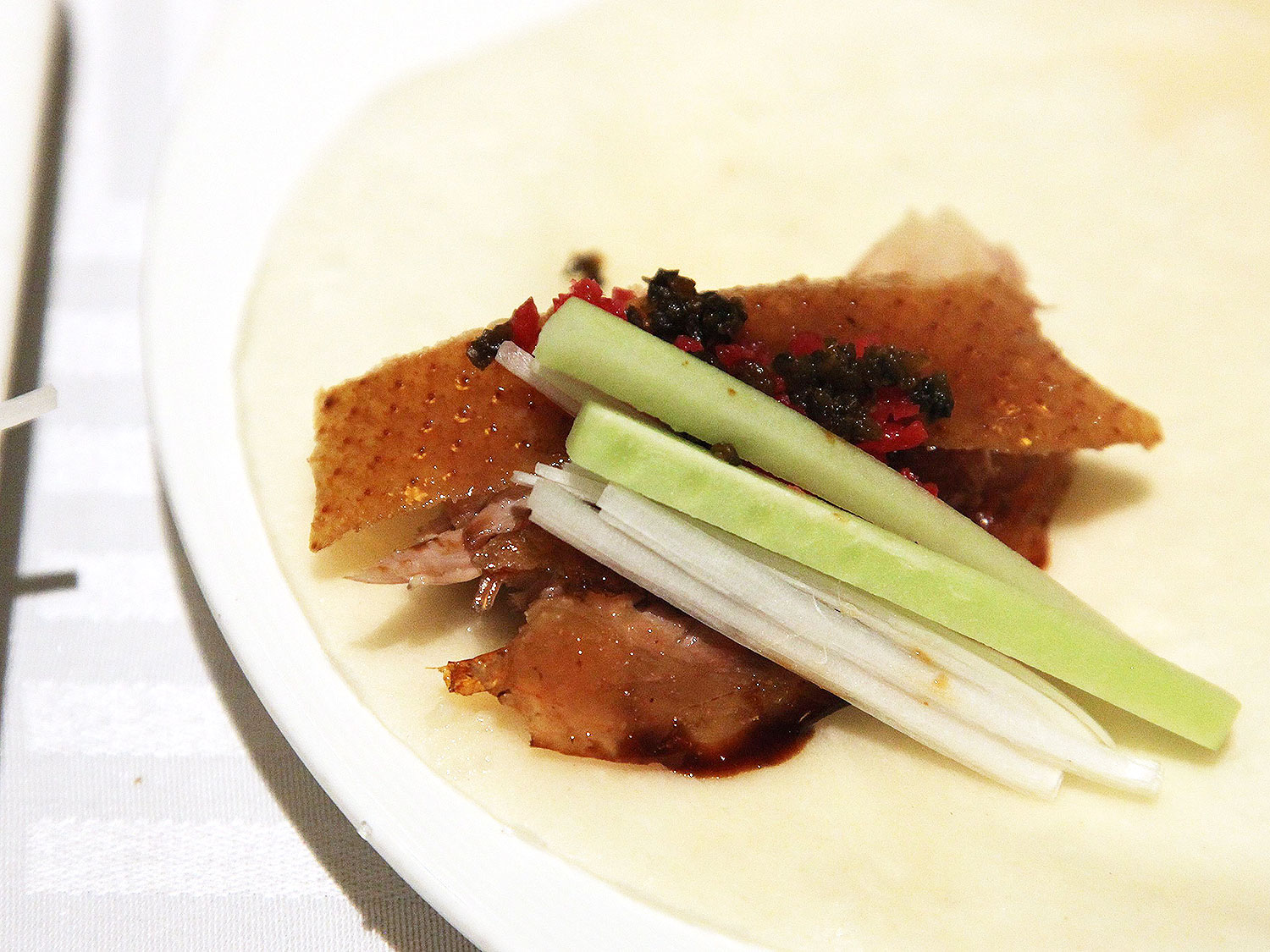
...followed by some cucumber batons.
Your duck is now ready to wrap.
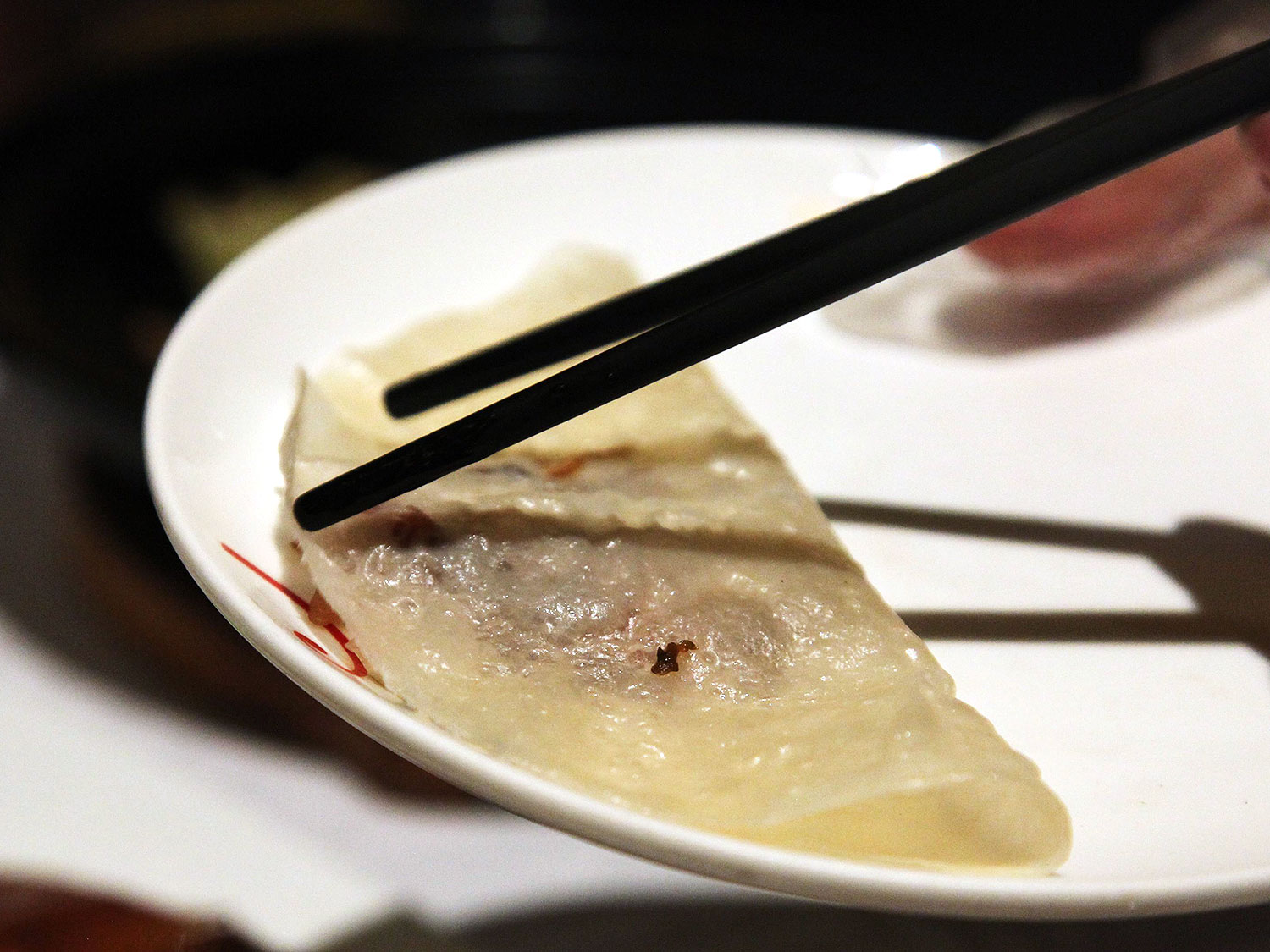
First the bottom folds over the top...

...followed by the edges. The idea here is to create a sealed package that will prevent the juices from leaking out of the bottom when you subsequently pick it up. When you do pick it up, make sure that the folded-over side is facing you, with the clean side facing outwards, lest you be mistaken for an uncouth heathen.*
*Though the idea of being judged as uncouth in a country where it's standard practice for grown men to hock loogies on the sidewalk and for parents to let children up to the age of five urinate (or worse) in the middle of public parks and streets is a little mind-numbing to me.
This ends your in-flight entertainment, though your waitress will probably stick around and watch you to make sure you get it before leaving you alone.
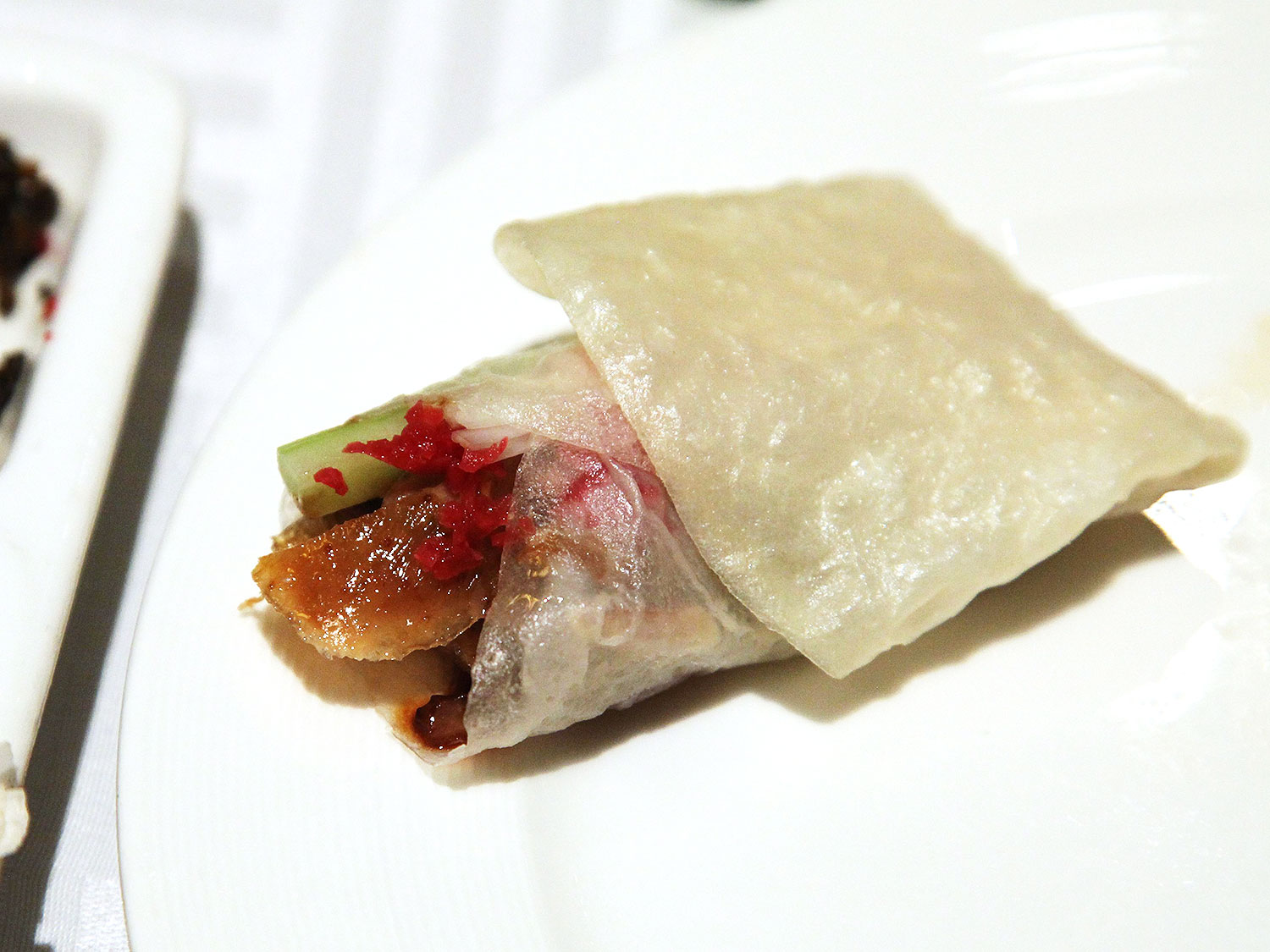
Your first solo-venture might look a bit like mine. I also accidentally overstuff my tacos and dumplings (doesn't everybody?).
With sides, a whole duck is easily enough of a meal for three to four people. Adri and I tried to tackle one on our own and fared admirably but still left behind half a platter of skin (I almost cried as the waitress took it back to the kitchen), and most of the scraps. We'll have to come back better prepared next time.
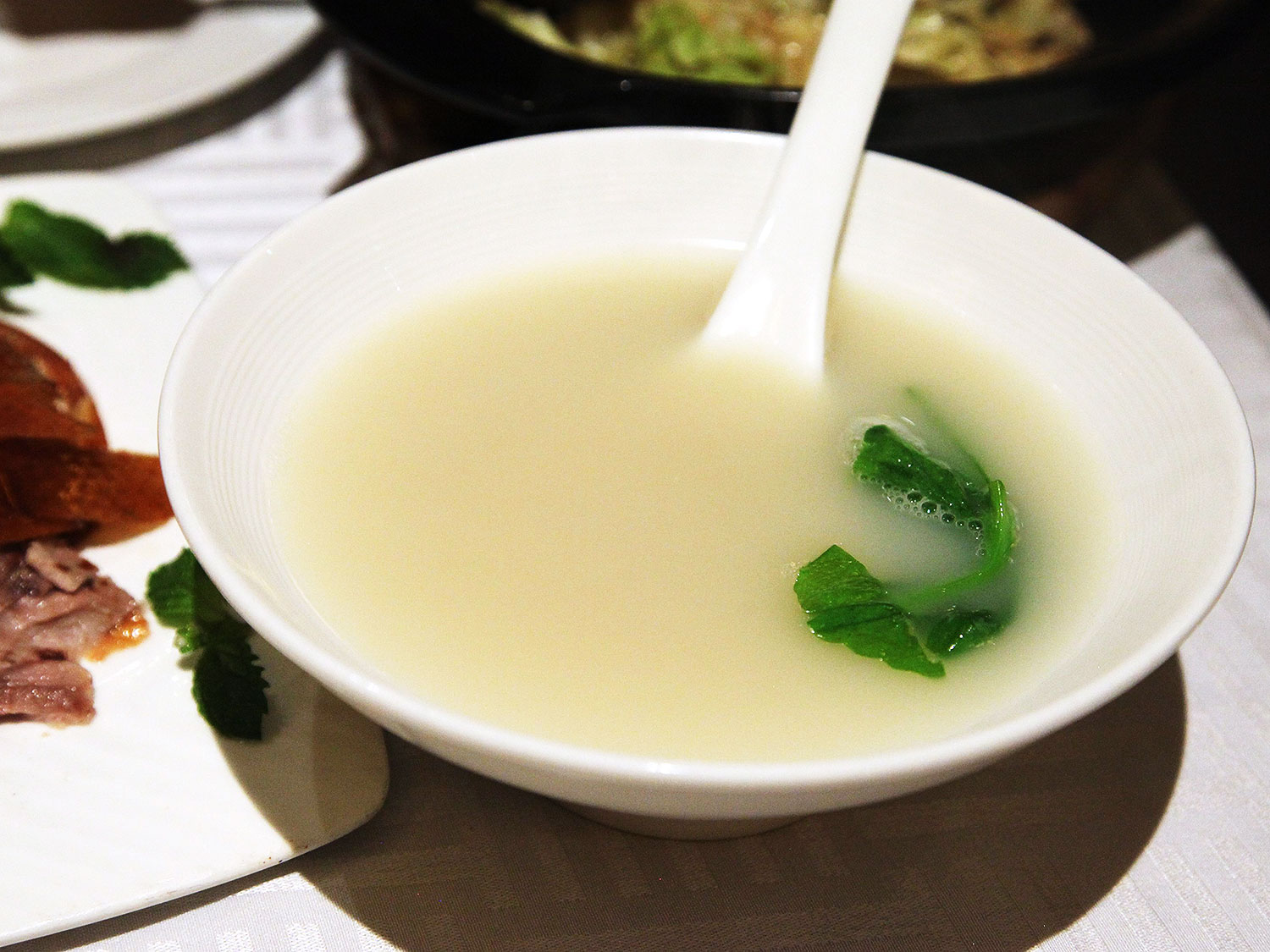
Meals end with a bowl of creamy white duck bone soup, served hot and intentionally bland—ours tasted mostly of white pepper with just a tiny pinch of salt—in order to cleanse your palate of the rich, flavor-packed duck you just finished.
I understand this concept from a philosophical perspective, but not from a practical one. Has anyone but a convalescent ever said "please sir, fetch me a bowl of your blandest broth that I may wash this glorious flavor from my lips."
Personally, I'd rather carry that duck around with me for a bit longer.